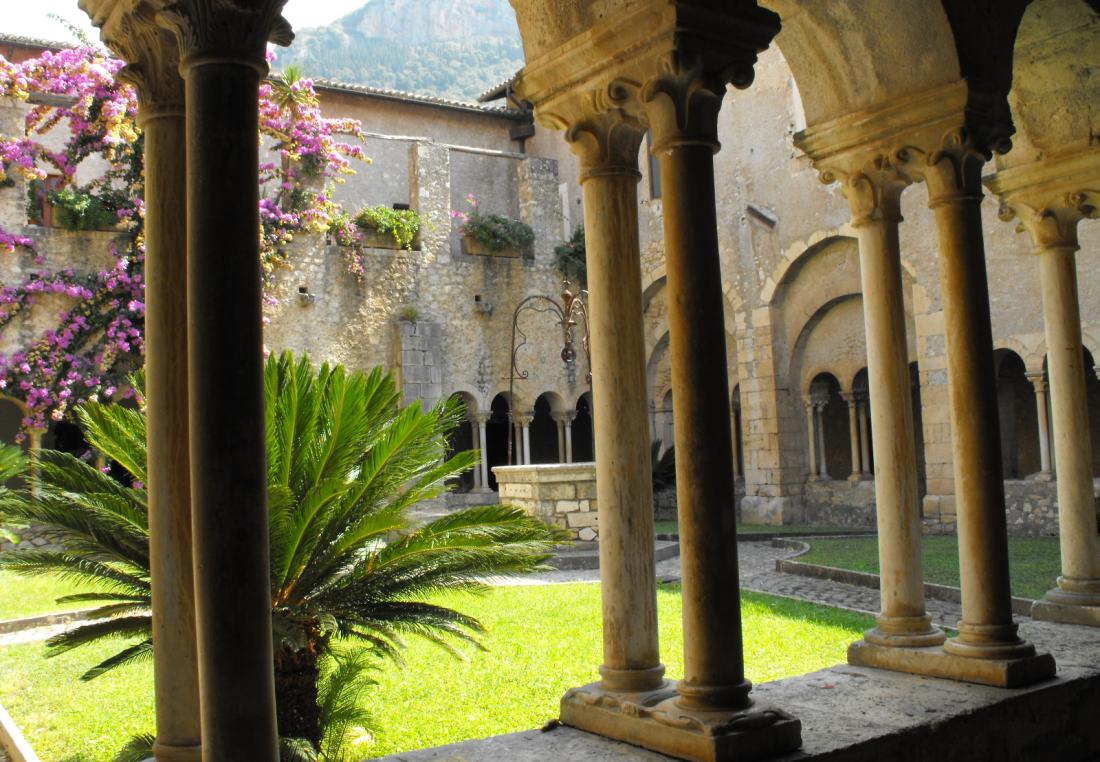Valvisciolo Abbey – Sermoneta
We are under the Corvino Mountain, part of the Volsci-Lepini (Pontine side, then the Tyrrhenian Sea) chain, at a height of about 100 meters s.l.m. And from this point you enjoy a panorama that stretches over the pontina plain, up to the Costa and the Prometory of the Circeo. Bottom, not far from here – in the past centuries – lay Pontine Marshes.
The Abbey stands on a raised plateau inside a small valley (whose name would be derived from the name of the Abbey itself) and this elevated position was considered indispensable for the defense against the stagnant water maladies.
The Abbey is located in the town of Sermoneta, but within the boundaries of its territory and so far away from the great village and medieval castle that dominated the ancient possessions of the Caetani family.
COMPLETE HISTORY
The origin of this Monastery (SS Pietro and Stefano di Valvisciolo) is quite complex and still presents some margins of doubt. It appears that, in the previous millennium, a colony of Brazilian monks had been installed here: the monastery was dedicated to Saint Peter. According to some sources, the Brasilians succeeded the Templars: this should have happened after the Troyes council (1128) where the Order was recognized by the Church. What is certain, in the year 200, however, the Cistercians of Fossanova officially took possession of the Monastery.
In the same epochs, in the territory of Carpineto (between the Lepini Mountains, not far from here) stood the ancient monastery of Malvisciolo (now known as Valvisciolo-old), of which few ruins remain). At the beginning of the 18th century the monks of Carpineto moved to this monastery, following the name of their saint (Saint Stephen) and their monastery (Malvisciolo, from which the name ‘Valvisciolo’ would arise if you do not want to believe in more autochthonous origins Of the name itself). Since then this Abbey has been called the SS. Peter and Stephen.
From 1400 the Abbey started a period of stasis, if not decadence, accentuated by the fact that it became (in 1411) commended the dependencies of Communist Abbots, usually known for considering these sinister assignments useful to the capital exploitation of the abbey possessions . In the 15th century the Cistercians went back to the 1600s and stayed until Napoleon’s expulsion. It was Pius IX which in the mid-eighties funded important restoration works so that in 1864 the Cistercians (of Casamari) returned to live in Valvisciolo.
ABBAZIAL COMPLETE No trace left of the previous plant attributed to Brazilian monks. The modern complex – of a modest size compared to the other great Cistercian abbeys of the same Lazio – is made of clear local stone and is centered on the Abbazia Church whose prospect (with a beautiful rosette) overlooks a large panoramic terrace.
The interior of the church is subdivided into three aisles with arched arches resting on large pillars, walls with paintings and no decorations of any kind, according to Cistercian canons. At the bottom of the left nave is the chapel dedicated to San Lorenzo with frescoes by Pomarancio (1588), designed by the Caetani family to honor Sisto V’s visit to their feudal estate.
To the right of the Church there is a beautiful cloister resting on columns fitted with capitals restored in times not far away; From it you access the beautiful Capitol Room and Refectory. The style of this complex has given rise to various discussions: some claim to have been built directly by the Templars according to their canons, others consider it to be made by different commands of origin, although – at least in the plan it is fairly faithful to the Bernardian canons.
In fact, the whole complex can in fact be defined as a simplified Cistercian style, to the point of being an architectural reference for many medieval – not large – sacred church buildings of nearby Ciociaria, such as the beautiful Gothic-Cistercian Churches of Alatri, Ferentino, Ceccano, where the Masters of Valviscolo lent their custom-made work to the mother-house of Fossanova.
FOR MOST INTERESTED OR CURIOS
1) VALIDITY NAME
If unclear is the story of this abbey as dubious is the origin of the name. The valley in which it is located is called ‘Visciole’ or as a medieval tradition, ‘of the Usignolo’ (in Latin ‘Vallis Lusciniae’): from here the origin of the present denomination could originate. But equally plausible is the hypothesis that it derives from the ancient name of Marmosolio or better still of Malvisciolo (the name of the monastery located in the territory of Carpineto whose monks had moved here in ‘300).
2) MYSTERY SIGNS
Already in the Cathedral of St. Mary, in the beautiful medieval center of Sermoneta, are displayed esoteric symbols, usually linked to places with pagan preesistances, and in particular the design of a triple celtic (of Celtic or Druidic tradition). The more numerous these symbols are in the Abbey of Valvisciolo and they are said to have been the Templars to trace them. In the perimeter walls of the Cloister there is repeatedly repeated a symbol of the ‘triple cutaway’ type (three concentric squares joined by perpendicular segments), while a wall – in a recent restoration – has shed light (graffiti on a Plaster) a Magic Square. It is a palindrome formed by the phrase Sator Arepo Tenet Opera Rotas, with the dark meaning (or perhaps it was just a fun).
3) THE END OF THE TEMPLARS
As Umberto Cordier reports – in the book ‘Guide to the mysterious places of Italy’ – circulates among the scholars of the unusual the hypothesis that at the time of the disappearance of a center of spiritual power (or a cult) for a kind of magic Nice ‘also the destruction of emblems or monuments related to it.
Well, it seems that when, in 1312, the Order of Templars was officially abolished and his Great Master given to the stake, the architraves of the churches already belonging to the Order broke. Here in Valvisciolo, where the presence of Templars is also attested by the existence of several ‘Templar Crosses’ (one is at the center of the Rosette), the architrave of the entrance portal is broken and various research on it attests that the damage is Which took place right at the time of the Great Master’s stake.
4) PROTOSTORIC NECROPOLES
Not far from the Monastery begins a narrow road that hangs for a few hundred meters in the mountains; It leads to Caracupa, where, at the beginning of the 20th century, an interesting Iron Age Necropolis was discovered, whose finds are now in the Museum of Prehistory of Latium (Pigorini Museum) in Rome-Eur.



